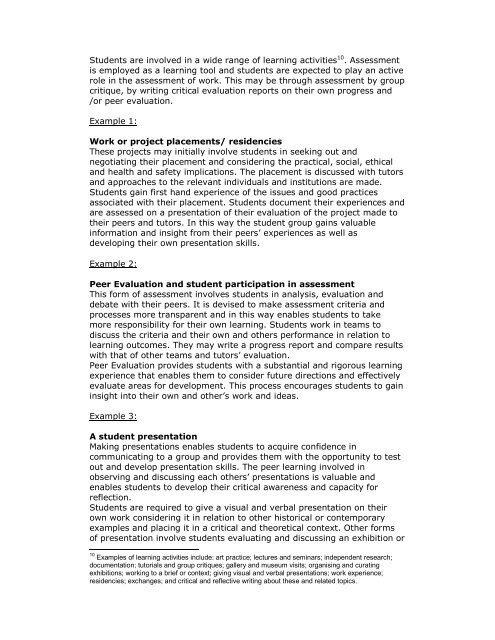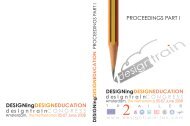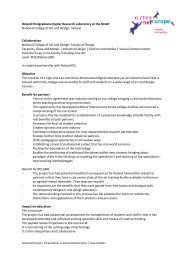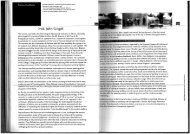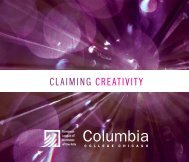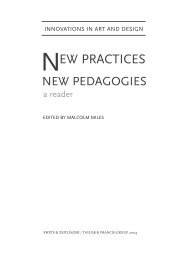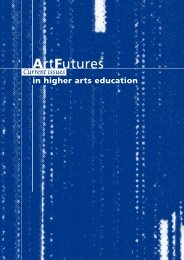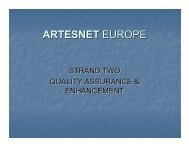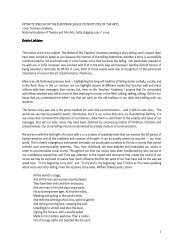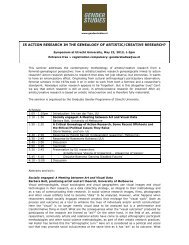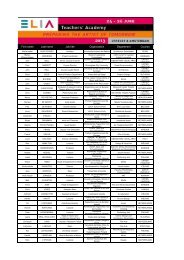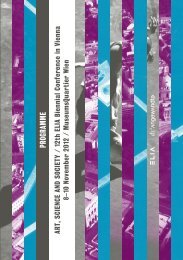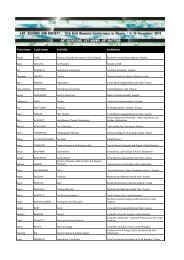CONTENTS FINE ART TUNING DOCUMENT - ELIA
CONTENTS FINE ART TUNING DOCUMENT - ELIA
CONTENTS FINE ART TUNING DOCUMENT - ELIA
You also want an ePaper? Increase the reach of your titles
YUMPU automatically turns print PDFs into web optimized ePapers that Google loves.
Students are involved in a wide range of learning activities 10 . Assessment<br />
is employed as a learning tool and students are expected to play an active<br />
role in the assessment of work. This may be through assessment by group<br />
critique, by writing critical evaluation reports on their own progress and<br />
/or peer evaluation.<br />
Example 1:<br />
Work or project placements/ residencies<br />
These projects may initially involve students in seeking out and<br />
negotiating their placement and considering the practical, social, ethical<br />
and health and safety implications. The placement is discussed with tutors<br />
and approaches to the relevant individuals and institutions are made.<br />
Students gain first hand experience of the issues and good practices<br />
associated with their placement. Students document their experiences and<br />
are assessed on a presentation of their evaluation of the project made to<br />
their peers and tutors. In this way the student group gains valuable<br />
information and insight from their peers’ experiences as well as<br />
developing their own presentation skills.<br />
Example 2:<br />
Peer Evaluation and student participation in assessment<br />
This form of assessment involves students in analysis, evaluation and<br />
debate with their peers. It is devised to make assessment criteria and<br />
processes more transparent and in this way enables students to take<br />
more responsibility for their own learning. Students work in teams to<br />
discuss the criteria and their own and others performance in relation to<br />
learning outcomes. They may write a progress report and compare results<br />
with that of other teams and tutors’ evaluation.<br />
Peer Evaluation provides students with a substantial and rigorous learning<br />
experience that enables them to consider future directions and effectively<br />
evaluate areas for development. This process encourages students to gain<br />
insight into their own and other’s work and ideas.<br />
Example 3:<br />
A student presentation<br />
Making presentations enables students to acquire confidence in<br />
communicating to a group and provides them with the opportunity to test<br />
out and develop presentation skills. The peer learning involved in<br />
observing and discussing each others’ presentations is valuable and<br />
enables students to develop their critical awareness and capacity for<br />
reflection.<br />
Students are required to give a visual and verbal presentation on their<br />
own work considering it in relation to other historical or contemporary<br />
examples and placing it in a critical and theoretical context. Other forms<br />
of presentation involve students evaluating and discussing an exhibition or<br />
10 Examples of learning activities include: art practice; lectures and seminars; independent research;<br />
documentation; tutorials and group critiques; gallery and museum visits; organising and curating<br />
exhibitions; working to a brief or context; giving visual and verbal presentations; work experience;<br />
residencies; exchanges; and critical and reflective writing about these and related topics.


